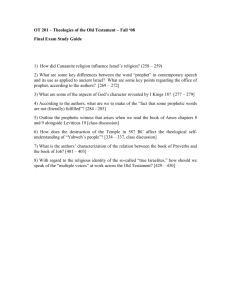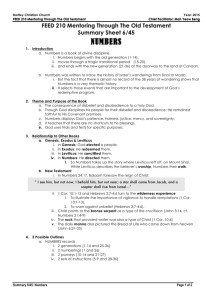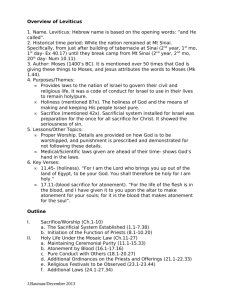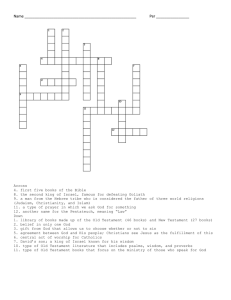Bible 110 Old Testament Leviticus Importance of Law
advertisement
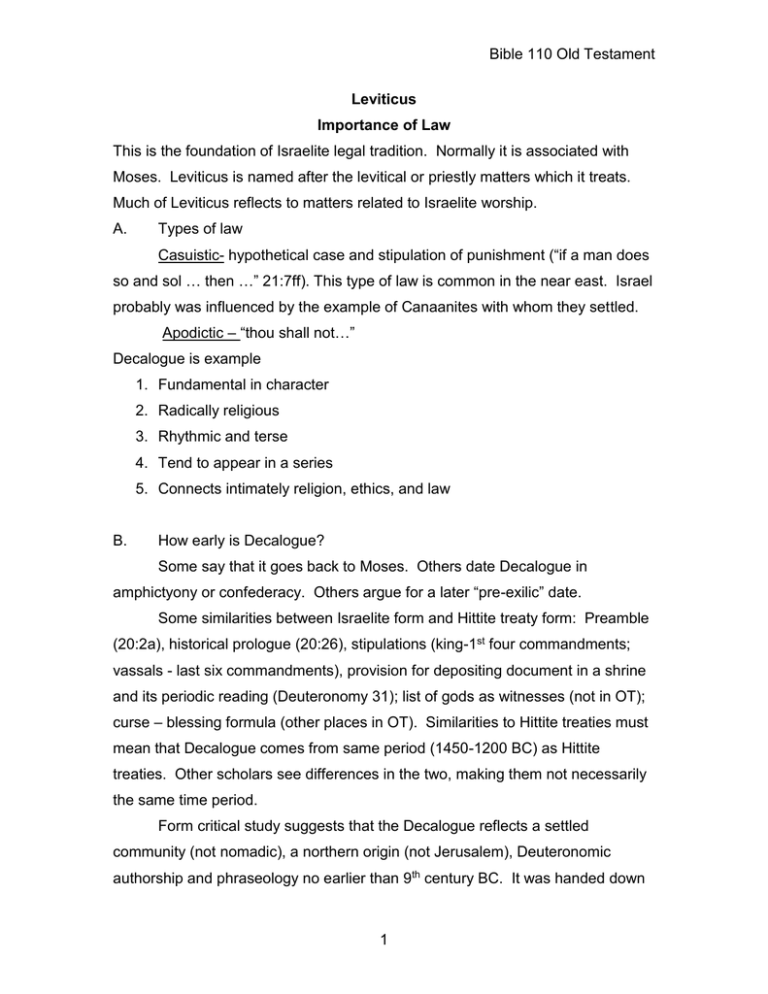
Bible 110 Old Testament Leviticus Importance of Law This is the foundation of Israelite legal tradition. Normally it is associated with Moses. Leviticus is named after the levitical or priestly matters which it treats. Much of Leviticus reflects to matters related to Israelite worship. A. Types of law Casuistic- hypothetical case and stipulation of punishment (“if a man does so and sol … then …” 21:7ff). This type of law is common in the near east. Israel probably was influenced by the example of Canaanites with whom they settled. Apodictic – “thou shall not…” Decalogue is example 1. Fundamental in character 2. Radically religious 3. Rhythmic and terse 4. Tend to appear in a series 5. Connects intimately religion, ethics, and law B. How early is Decalogue? Some say that it goes back to Moses. Others date Decalogue in amphictyony or confederacy. Others argue for a later “pre-exilic” date. Some similarities between Israelite form and Hittite treaty form: Preamble (20:2a), historical prologue (20:26), stipulations (king-1st four commandments; vassals - last six commandments), provision for depositing document in a shrine and its periodic reading (Deuteronomy 31); list of gods as witnesses (not in OT); curse – blessing formula (other places in OT). Similarities to Hittite treaties must mean that Decalogue comes from same period (1450-1200 BC) as Hittite treaties. Other scholars see differences in the two, making them not necessarily the same time period. Form critical study suggests that the Decalogue reflects a settled community (not nomadic), a northern origin (not Jerusalem), Deuteronomic authorship and phraseology no earlier than 9th century BC. It was handed down 1 Bible 110 Old Testament to Jerusalem (south) later both through prophetic influence and through the influence of the cultus. Cultic use of Exodus 20 and Deuteronomy 5 has changed them from gracious expression of covenantal relation to terrifying, aweinspiring law of God. Nielsen suggested that some of the laws reflected a nomadic period, some reflect pre-monarchical period, some a settled, urban existence. Decalogue in north put restrictions on royal authority, power. After 722 BC it moved south to Jerusalem royal theology. It became converted to covenant form by the Deuteronomic authors. C. Contents of Leviticus Laws and regulations covering those aspects of life in which a priest was involved, either as a leader in worship or special guardian of Israel’s holy nature. The regulations in Leviticus are organized around the offering of sacrifice to God, organization of priesthood, and many other matters. It may be called a guidebook for Israel in the matter of daily living as “a kingdom of priests and a holy nation.” Manual of Sacrifice 1-7 Historical narrative 8-10 Laws of hygiene 11-15 Day of Atonement 16 Holiness Code 17-26 Religious ideas in Leviticus: 1. God is present with his people 2. God is perfectly holy; his presence with Israel extends this holiness to cover the whole of life of the nation 3. God’s will is that his people should live in holy relationship with Him. This was given expression by the gracious act of election by God (at Sinai) into covenant with Himself. 2 Bible 110 Old Testament Manual of Sacrifice 1:1-7:38 Burnt offering 1:1-17 Cereal offering 2:1-16 Peace offering 3:1-17 Sin and guilt offerings 4:1-6:7 Instructions for priests regarding sacrifices 6:8-7:38 Historical narrative: Beginning of Israel’s worship at Sinai 8:1-10:20 Consecration of Aaron and sons to be Israel’s priests 8:1-36 First public sacrifice in Israel 9:1-24 Error of Nadab and Abha 10:1-20 Laws of Hygiene 11-15 Clean and unclean animals 11:1-47 Israelites may eat beasts that parts the hoof and is cloven-footed and chews cud. May not eat carnel, rock badger, hare, or swine. Israelites may eat in waters, rivers, seas everything that has fins and scales. May not eat things which do not have fins and scales. May not eat eagle, vulture, osprey, kite, falcon, raven, ostrich, nighthawk, seagull, hawk, owl, cormorant, ibis, water hen, pelican, carrion vulture, stork, heron, hoopoe, bat, etc. Uncleanness connected with child birth 12:1-8 A woman is unclean longer after giving birth to female than after giving birth to a male. Uncleanness arising from leprosy 13:1-15:33 Diagnosis of disease 13:1-46 Identification of disease in clothes 13:47-59 Offerings for cleansing 14:1-32 Procedure for leprosy in houses 14:33-57 Uncleanness through bodily discharges 15:1-33 Day of Atonement 16:1-34 Holiness code 17:1-26:46 3 Bible 110 Old Testament Offering of sacrifices and the eating of meat 17:1-16 Regulations concerning marriage 18:1-30 Incest forbidden General list of laws 19:1-37 Laws carrying the death penalty 20:1-27 He who curses father or mother Man who commits adultery with wife of neighbor Man who commits adultery with daughter-in-law Man who lies with male as woman Man who lies with a beast Woman who lies with a beast Etc. Holiness of priests 21:1-24 Holiness of Offering 22:1-33 Calendar of Feasts 23:1-44 Festivals of divine appointment 23:1-3 Spring Festival 23:4-14 Early summer festival 23:15-22 Fall festival 23:23-44 Regular worship at sanctuary 24:1-9 Validity of Israel’s law for foreigners 24:10-23 (eye for an eye) Sabbatical year and year of Jubilee 25:1-26:2 (laws of redemption, loans, slavery) Blessings and curses 26:3-46 Laws rejecting oaths and gifts 27:1-34 4
